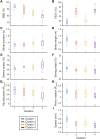Beyond clinical scales: an observational study on instrumental gait analysis and biomechanical patterns in patients with Parkinson's disease
- PMID: 40370594
- PMCID: PMC12075126
- DOI: 10.3389/fbioe.2025.1541240
Beyond clinical scales: an observational study on instrumental gait analysis and biomechanical patterns in patients with Parkinson's disease
Abstract
Introduction: Parkinson's disease (PD), a common neurodegenerative disorder affecting motor functions, is associated with abnormal gait patterns characterized by altered kinematic, kinetic, and electrophysiological parameters. This observational study aims to instrumentally identify and quantify these gait dysfunctions in PD patients compared to normal values from healthy subjects.
Methods: Sixty-nine PD patients underwent clinical and instrumental evaluations to assess gait. Demographic and clinical data were collected before motor assessment. Clinical scales evaluated the level of impairment, gait, balance, risk of falls and ability to complete activities of daily living. Instrumental evaluations were conducted using optoelectronic, force plates and electromyographic (EMG) systems in a motion analysis laboratory. Statistical analysis involved a non-parametric test to compare pathological and normal data, clustering methods to identify groups based on clinical evaluations, and a combination of non-parametric analysis and linear models to assess dependencies on clinical scales.
Results: The results showed that PD patients had significant gait kinematic differences compared to normal values, with increased temporal and shortened spatial parameters. In addition, PD patients were grouped into four clusters based on clinical scales. While some gait features were influenced by clinical scales reflecting impairment, gait and balance, and independence, others were more affected by the perceived fear of falling (FoF).
Discussion: In conclusion, the study identified specific biomechanical gait dysfunctions in kinematic, kinetic, and electrophysiological parameters in PD patients, undetectable by standard clinical scales. Additionally, higher FoF was associated with dysfunctional biomechanical patterns, independent of impairment severity, gait and balance dysfunction, or overall independence.
Keywords: Parkinson’s disease; biomechanics of gait; fear of falling; gait analysis; neurorehabilitation; neurorehabilitation gait analysis; optoelectronic motion capture system.
Copyright © 2025 De Pasquale, Bonanno, De Marchis, Pergolizzi, Lombardo Facciale, Paladina, Maggio, Impellizzeri, Ciancarelli, Quartarone and Calabrò.
Conflict of interest statement
The authors declare that the research was conducted in the absence of any commercial or financial relationships that could be construed as a potential conflict of interest.
Figures




Similar articles
-
Gait Characteristics Associated with Fear of Falling in Hospitalized People with Parkinson's Disease.Sensors (Basel). 2023 Jan 18;23(3):1111. doi: 10.3390/s23031111. Sensors (Basel). 2023. PMID: 36772149 Free PMC article.
-
Factors associated with fear of falling in people with Parkinson's disease.BMC Neurol. 2014 Jan 24;14:19. doi: 10.1186/1471-2377-14-19. BMC Neurol. 2014. PMID: 24456482 Free PMC article.
-
Fear of Falling Does Not Influence Dual-Task Gait Costs in People with Parkinson's Disease: A Cross-Sectional Study.Sensors (Basel). 2022 Mar 5;22(5):2029. doi: 10.3390/s22052029. Sensors (Basel). 2022. PMID: 35271176 Free PMC article.
-
A multimodal Parkinson quantification by fusing eye and gait motion patterns, using covariance descriptors, from non-invasive computer vision.Comput Methods Programs Biomed. 2022 Mar;215:106607. doi: 10.1016/j.cmpb.2021.106607. Epub 2021 Dec 30. Comput Methods Programs Biomed. 2022. PMID: 34998167 Review.
-
Measurement instruments to assess posture, gait, and balance in Parkinson's disease: Critique and recommendations.Mov Disord. 2016 Sep;31(9):1342-55. doi: 10.1002/mds.26572. Epub 2016 Mar 4. Mov Disord. 2016. PMID: 26945525 Review.
Cited by
-
Use of Wearable Sensors to Assess Fall Risk in Neurological Disorders: Systematic Review.JMIR Mhealth Uhealth. 2025 Aug 18;13:e67265. doi: 10.2196/67265. JMIR Mhealth Uhealth. 2025. PMID: 40824690 Free PMC article. Review.
-
Neural control meets biomechanics in the motor assessment of neurological disorders: a narrative review.Front Neural Circuits. 2025 Jun 27;19:1608328. doi: 10.3389/fncir.2025.1608328. eCollection 2025. Front Neural Circuits. 2025. PMID: 40657418 Free PMC article. Review.
References
LinkOut - more resources
Full Text Sources

